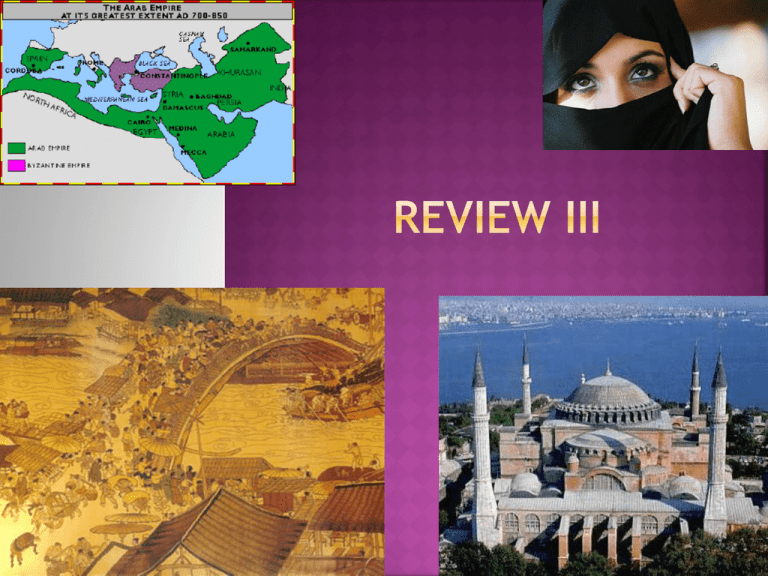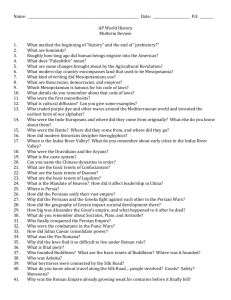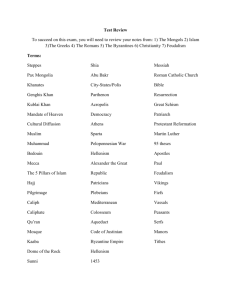Review III - White Plains Public Schools
advertisement

Major teachings: devotion to God and love for fellow man His message, “The kingdom of God is at hand” seemed to threaten Rome because it divided allegiances After the Crucifixion, devotion to him grew rapidly; called the Christ (Greek for Messiah, or “the anointed one”) His teachings spread throughout the Roman Empire Christians would not worship the gods of the Roman Empire Worshipped a single God Appealed to the lower classes (urban dwellers and women) Taught equality of the sexes and encouraged men and women to achieve great things Early Christians were persecuted by the Romans for failing to worship the Roman gods Approximately three hundred years after the Romans crucified Jesus, a Roman emperor (Constantine) converted to Christianity Southeastern Asia, China, and India traded: silk and spices west to consumers in central Asia, Iran, Arabia, and the Roman Empire Spices were important because they had numerous purposes (food preservative and flavoring and pharmaceutical) Central Asia traded horses, jade, and magic potions west Trade route that connected the Han and Roman Empires in classical times Facilitated the exchange of goods, ideas, and disease Following the fall of the Han and Roman Empires, the route was revived in post-classical times, first by the Tang and Song and later the Mongols Problems: internal opposition, power struggle (26 people claimed the throne), generals struggled for power and died violently, empire was simply too large, epidemics Diocletian divided the empire into two districts: eastern (Anatolia, Syria, Egypt, and Greece) and western (Italy, Gaul, Spain, Britain, and North Africa) Germans migrating from the north attacked the western half; especially powerful were the Visigoths Hun invasions, led by Attila, pressured other Germanic tribes to invade: Ostrogoths, Vandals, and Franks Ended imperial Roman power in western Europe by 476 C.E.; power later shifts to Byzantium in the east Nomadic Germanic tribes – Visigoths, Huns (led by Attila), Ostrogoths, Vandals, and Franks – encountered little effective resistance Controlled the western half of the Roman empire: Italy, Gaul, Spain, Britain, and North Africa Led to decentralized rule and to the establishment of the feudal system Emperor Constantine accepted Christianity in 313 C.E. He then relocated the capital of the Roman Empire to Constantinople in the east because the eastern Mediterranean was wealthier and allowed him to spy on enemies in the East With the fall of the Western Roman Empire, the eastern half became known as the Byzantine Empire and included lands in Greece, the Balkans, Anatolia, Syria, Palestine, Egypt, and northeastern Africa Roads and communication systems, emperors above law – claiming divine rights Justinian (reigned 527-565 C.E.) was a very important emperor during the early Byzantine empire; his wife, Theodora, advised him on political, religious, and diplomatic issues Built great public works, including the Hagia Sophia, a cathedral that became a mosque following the Ottoman Turks’ conquest of Constantinople After a systematic review of all laws of the republic, Justinian codified Roman law, keeping legal principles of ancient Rome Published Corpus juris civilis (Body of Civil Law) Justinian’s Code has remained an inspiration for civil law codes Lower Danube region was the breadbasket of the empire Byzantine government prevented wealthy classes from seizing peasants’ lands The wealthy could buy exemptions from taxes Craftsmen were highly respected for their handiwork in areas of glassware, gems, jewelry, and mosaics (used to decorate churches) Architectural gems – Hagia Sophia (church, later mosque) Byzantine government recognized the importance of the silk industry (a trade borrowed from the Chinese) and subsequently closely supervised its production and sale Trade important as a direct result of location Greek replaced Latin as the official language of the Byzantine Empire Byzantine scholars, like Greek scholars, focused on literature, history, and philosophy; their legacy was the preservation of Greek culture Byzantine preservation of Greek and Roman cultures was transmitted back to western Europe during the Crusades Turks invaded from the east and conquered Constantinople (later renamed it Istanbul) Byzantines lost Anatolia (their breadbasket), which led to their ultimate demise (they had no food source) Russia created several trading centers, including Kiev along the Dnieper River In 989 C.E., Prince Vladimir of Kiev converted to Orthodox Christianity as a result of his exposure to Byzantium; his subjects followed Other Byzantine influences included the Cyrillic alphabet, writing, codified laws, and art and architecture (for example, onion domes) After Constantinople fell, Russia named Moscow the world’s third Rome – insinuating that they had inherited the imperial power, as the Byzantines had inherited from the Romans Center of Orthodox Christianity shifts northward Specialized labor and efficient means of transportation encouraged trade between groups such as the Mesopotamians and the Egyptians as early as 3500 B.C.E. Sumerians, who needed natural resources, traded regularly with the Harappan society by 2300 B.C.E. Sumerians shipped woolen textiles, leather goods, sesame oil, and jewelry to India in exchange for copper, ivory, pearls, and semiprecious stones Egyptian pharaohs imported cedar, a sign of wealth, for tombs Smallpox and measles were the most pervasive; bubonic plague also broke out Problem: epidemics devastated communities because they had no immunities and no medicines to fight against them Smallpox devastated the Roman Empire – reduced population by approximately one-quarter during the second century B.C.E. Epidemics appeared later in China Epidemics led to social change; trade decline, and people learned to be selfsufficient About 610, Muhammad had a transformational spiritual experience and traveled through the Arabian Peninsula proclaiming that he was the last prophet of Allah He believed in one God (Allah) Allah’s words were given to Muhammad and collected by his followers and compiled in the Quran Hadith, a record of sayings attributed to Muhammad and accounts of the prophet’s deeds, serve as a guide for the interpretation of the Quran and for social and legal customs Muhammad’s journey to Mecca became a symbolic starting point of the official Islamic calendar and a religious pilgrimage for the followers of Islam Rapid expansion in the century after Muhammad’s death was the work of early caliphs who spread the word through pilgrimages Between 633 and 637, Muslims took control of Byzantine Syria and Palestine and seized most of Mesopotamia from the Sassanids During the 640s Muslims conquered Byzantine Egypt and North Africa By 651, Muslims controlled the Sassanid dynasty and Persia By 718, Muslims controlled Hindu India, northwestern Africa, and the Iberian peninsula Muslims allowed conquered people (Christians and Jews) to maintain traditions but paid jizya (tax) In 750, the Umayyad Dynasty ended after a rebellion in Persia led by Abu al-Abbas, who founded the Abbasid dynasty, the main source of power in dar al-Islam (House of Islam) Abbasids were headquartered in Baghdad Focused energy on ruling their empire, which included a variety of linguistic, cultural, religious, and ethnic groups Trade arrangements held the empire together Officials included ulama, religious experts, and qadis, judges; both resolved local disputes and set moral standards The empire continued to grow as a result of independent military forces Commercial centers in Nishapur, Bukhara, and Samarkand facilitated the revival of trade over the Silk Road (perpetuated by Muslims) Classical roads, originally commissioned by India and Persia and revived by Muslims, provided quick and efficient travel through dar al-Islam Overland trade was conducted by camel caravan Caravansaries provided lodging, food, and water for traveling merchants and their animals Technological advances, such as the compass, the lateen sail, and the astrolabe led to increasing travel in the Red Sea, Persian Gulf, Arabian Sea, and Indian Ocean Abbasids encouraged large-scale trade by reinstituting letter of credit – sakk (checks) The Quran helped and hurt women Improved the security of women in Arabian society: outlawed female infanticide and ruled that dowries go to brides, not husbands Described women as honorable individuals equal to men, not property Both the Quran and sharia (Islamic law) emphasized male dominance: descent through the male line, male inheritance, strict control of women by male guardians Social customs were influenced by Islamic beliefs: men were permitted to take up to four wives (polygamy), women were veiled in public Arabic term referring to the “house of Islam” and the lands under Islamic rule Persian influences: administrative techniques; ideas of kingship (greatly influenced caliphs); Persian, the language of literature, poetry, history and political thought (for example, The Arabian Nights) Indian influences: mathematics, Arabic/Hindi numbers, symbol for zero, algebra, trigonometry, geometry Greek influences: philosophy, science, medical writings (especially Plato and Aristotle), Arabic libraries and museums held translated Greek and Roman works Muslim forces reached India by the mid-seventh century Muslim merchants reached the northern and southern coasts of India; Islam was spread easily using connections established through relationships with Arabs and Persians prior to Muhammad Migrations and invasions of Turkish-speaking people from central Asia Mahmud Ghazni, the Turkish leader in Afghanistan, destroyed hundreds of Hindu and Buddhist sites; Buddhism’s decline ironically did not tarnish Islam’s reputation with Indians Sultans ruled Punjab to the Ganges valley from 1206 to 1536 After centuries of turmoil following the Han dynasty, the Sui emerged to restore peace and order Public works included palaces, granaries, and repair of defensive walls; most elaborate project was the Grand Canal Grand Canal: a series of artificial waterways that connected Hangzhou to Chang’an The Grand Canal linked the northern and southern economies of China 610s: rebellions broke out in northern China 618: emperor Sui Yandi was assassinated and dynasty ended Ruled China beginning in 618 C.E. Expanded into parts of Manchuria, Mongolia, Tibet, and Korea By 907, the empire became so large that local warlords gained more and more power, and the T’ang dynasty collapsed A golden age of Chinese culture Poetry made the T’ang Dynasty truly unique T’ang poetry tells about daily life in China during the time Also, art, architecture, science, philosophy, porcelain, silk, and transportation systems Followed the Tang Dynasty; first emperor, Song Taizu, started policy of distrust of military leaders – focused on civil service exams (based on Confucian philosophy), industry, education, and the arts Financial problems faced by the Song: bureaucracy too big Military problems: scholar bureaucrats’ limited military experience led Song to military failures Also, considered a golden age along with T’ang Many advances in science and arts Advances were made possible as a result of abundant food supplies High-quality porcelain Metallurgical technologies: iron and steel were made stronger by using coke instead of coal to get a higher furnace temperature Military advances: gunpowder was ultimately used effectively in military battles Printing technology: texts were produced faster, cheaper, and in greater quantities Developed in response to growing popularity of Buddhism Combined Confucian beliefs with the writing of Buddhism but civil service examination continued to be used to staff government positions Buddhism was appealing because it offered a tradition of logical thought Neo-Confucian philosopher Zhu Xi (1130-1200) wrote Family Ritual stressing appropriate personal behavior and social harmony Neo-Confucianism is important because it shows the influence that Buddhism had on Chinese society and throughout East Asia An agricultural society inspired by T’ang China, instituted a series of reforms to centralize power Nara was built as a replica of Chang’an Japan fused traditional Shinto beliefs with Chinese Buddhism and Confucianism Heian period power centralized in Fujiwara family Women contributed to Japanese literature (Lady Murasaki’s Tale of Genji) Decline resulted from a failure of the equalfield system; land became concentrated in the hands of a small group of wealthy elite Includes Kamakura and Muromachi periods Characterized by decentralized political power in which regional warlords (daimyo) controlled land and economy (Chinese-style bureaucracy was abandoned) Valued military talent and discipline Samurai (mounted warriors) played an important role in Japanese society observed bushido (way of the warrior) emphasized loyalty to the warrior’s lord Medieval period ended by Tokugawa dynasty, which centralized power and unified Japan European feudalism valued warriors (knights) and way of warrior (chivalry) Franks built a society based on agriculture in northern region of Europe and oversaw the development of decentralized political institutions in those areas Clovis (strong political and military leader) led successful campaigns; one campaign finally ended Roman authority in Gaul and established Franks as most powerful and dynamic of new states in western Europe Clovis converted to Christianity and thereby gained the support of Christians from former Roman Empire Frankish unification of western Europeans made possible Muslim defeat at Tours in 732 High point for the Franks came under Charlemagne, who quelled disputes between local leaders when he reclaimed centralized imperial rule Charlemagne extended the empire into northeastern Spain, Bavaria, and Italy and as far south as Rome Traveled through his empire during most of his reign Legitimacy of his empire pronounced by the Roman Catholic Church Established a new group of imperial officials in an effort to increase control of central government; missi dominici (“envoys of the lord ruler”)







